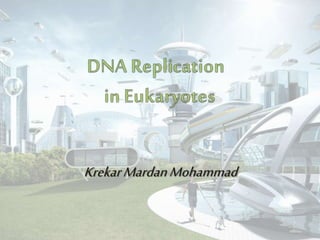
DNA Replication Process Explained in Detail
- 2. REPLICATION It is a process in which the DNA copies itself to produce identical daughter molecules of DNA. It occurs only once in each cell. It occurs very quick, accurate and at correct time. Replication of DNA occurs based on the Chargaff’s Rule that is Cytosine – Guanine ( 3 H bonds) Adenine – Thymine (2 H bonds)
- 3. Modes of Replication Delbruck suggest that Watson-Crick model of DNA could theoretically be replicated by three modes Conservative Semi-conservative dispersive
- 5. Simple Process G1 •Replication initiated S •DNA synthesis occur •Two daughter copies are produced G2 •Repair mechanisms occur Finally, one copy of the genomes is segregated to each daughter cell at mitosis or M phase. These daughter copies each contain one strand from the parental duplex DNA and one nascent anti-parallel strand. This process is conserved from prokaryotes to eukaryotes and the mechanism is called semi-conservative mode of replication.
- 6. ComplexProcess DNA replication in eukaryotes divided into three stages 1. Initiation ( Formation of Pre – Replicative Complex) 2. Initiation complex 3. Elongation (Replication fork and Polymerization) 4. Termination
- 7. Initiation of Replication It is the first step in eukaryotic replication in which most of the proteins combines to form Pre – Replicative complex (Pre-RC). Involved proteins Origin Recognition complex (ORC) Cell division cycle 6( Cdc 6) Chromatin licensing and DNA Replication factor 1( Cdt 1) Minichromosome Maintenance Protein Complex (Mcm 2- 7)
- 8. Steps in initiation ORC binds in the Ori-c Site of the DNA Recruits the Cdc 6 Cdc 6 Binds with ORC in ATP dependent manner Cdc 6 recruits the Cdt 1 Cdt 1 is required for licensing the chromatin for Replication Cdt 1 binds with C terminus of Cdc 6 Finally binding all three protein recruit Mcm Mcm finally binds with Chromatin These following steps occur in G1 phase of cell cycle
- 10. The activity of Cdt 1 during the cell cycle is regulated by a protein called Geminin. It also inhibits Cdt 1 activity during the S phase in order to prevent the re-replication of DNA, Ubiquitination and proteolysis.
- 11. Functions of Mcm Complex Minichromosome Maintenance Complex has helicase activity and inactivation of any of the six protein will prevent the progress of formation of replication fork. It also has ATPase activity. A mutation at any one of the Mcm protein complex will reduce conserved ATP binding site. Mcm complex is a hexamer with Mcm 3, Mcm 7, Mcm 2, Mcm 6, Mcm 4, Mcm 5.
- 12. Initiation Complex It is the 2nd stage in DNA replication where the Pre – Replicative complex is converted into Initiation complex. Involved proteins Cell Division Cycle 45 ( Cdc 45) GINS Cyclin Dependent Kinase ( CDK) Dbf 4 Dependent Kinase (DDK) – Combination of Cdc 7 and dbf 4
- 13. Steps in initiation complex Cdc 45 protein is a compound which is need for the conversion of Pre – RC into initiation complex. Its binds with chromatin after the beginning of initiation in late G1 phase by physically associated with Mcm 5. The binding of Cdc 45 is based on Clb - Cdc 28 as well as the function of Cdc 6 and Mcm. GINS are essential for interaction of Mcm and Cdc 45 at Ori-c site during initiation.
- 14. GINS complex is composed of four small proteins namely Sld5 (Cdc105) Psf1 (Cdc101) Psf2 (Cdc102) Psf3 (Cdc103) GINS represents 'go, ichi, ni, san' which means '5, 1, 2, 3' in Japanese.
- 15. At the onset of S phase, the pre-replicative complex must be activated by two S phase-specific kinases in order to form an initiation complex at an origin of replication. One kinase is the Cdc7-Dbf4 kinase called Dbf4-dependent kinase (DDK) and the other is cyclin-dependent kinase (CDK). The CDK-dependent phosphorylation of Cdc6 has been considered to be required for entry into the S phase. DDK targets the Mcm complex, and its phosphorylation leads to the possible activation of Mcm helicase activity.
- 16. Elongation Once the initiation complex is formed and the cells pass into the S phase, the complex then becomes a replisome and elongation is initiated. Once the elongation is initiated, it form the replication fork by unwinding the DNA strand. As the double helix of DNA separates from one side and super coils are formed on the other side. The problem of super coils comes in the way of DNA replication is solved by a group of enzymes called DNA topoisomerase.
- 17. Replication Fork The replication fork is the junction the between the newly separated template strands, known as the leading and lagging strands, and the double stranded DNA. Elongation occur in 5’ to 3’ direction in both the leading and lagging strand.
- 19. Leading Strand The leading strand is the template strand that is being replicated in the same direction as the movement of the replication fork. Nucleotides are added by the DNA Polymerase ε. DNA polymerase requires the RNA primer produced by Primase. Elongation take place in 5’ to 3’ direction. Finally the primer are removed by RNAse H and the gap is sealed by the DNA Ligase 1.
- 20. Lagging Strand DNA replication on lagging strand is discontinuous and elongation opposite direction to replication fork. Nucleotide are added by the DNA Polymerase δ. Lagging strand used more RNA Primer for loading nucleotide. DNA polymerase will synthesize short fragments of DNA called Okazaki fragments which are added to the 3' end of the primer. These fragments can be anywhere between 100-400 nucleotides long in eukaryotes.
- 21. Step 1 = Binding Step 3 = Translocation The binding- polymerization- translocation cycle can occurs many times This greatly lengthens one of the strands The complementary strand is made by primase, DNA polymerase and ligase RNA primer Step 2 = Polymerization
- 22. MERCi
Notas del editor
- T
